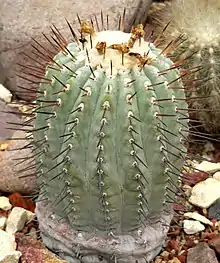Copiapoa cinerea
Copiapoa cinerea is a species of plant in the genus Copiapoa in the family Cactaceae. The epithet cinerea comes from the Latin word for ash, by reference to the color of the epidermis.
| Copiapoa cinerea | |
|---|---|
 | |
| Scientific classification | |
| Kingdom: | Plantae |
| Clade: | Tracheophytes |
| Clade: | Angiosperms |
| Clade: | Eudicots |
| Order: | Caryophyllales |
| Family: | Cactaceae |
| Subfamily: | Cactoideae |
| Genus: | Copiapoa |
| Species: | C. cinerea |
| Binomial name | |
| Copiapoa cinerea | |
Description
This cactus is globular, fleshy, and perennial, then columnar up to 1 m (3.3 ft) tall, 20 cm (7.9 in) in diameter, with 30 ribs. Typical of this species, and characteristic, is the production of a white-colored waxy cuticle, for which the plants in its habitat are decidedly white-grey in color, hence the specific epithet. The light coloration is a protection against desiccation. In culture, the epidermis is often greenish. Its thorns can assume different colors, depending on the populations, however Copiapoa cinerea is generally black or dark brown. Only old plants offset from the base.
Flowers are yellow, with a diameter of 2.5 cm (0.98 in), at the top of the plants.The fruit ripens between wools, and is only visible when ripening has already occurred.
Subspecies
| Image | Name | Distribution |
|---|---|---|
 | Copiapoa cinerea subsp. cinerea | Chile (Antofagasta to Atacama) |
 | Copiapoa cinerea subsp. columna-alba (F.Ritter) D.R.Hunt | Chile (SW. Antofagasta to Atacama) |
.jpg.webp) | Copiapoa cinerea subsp. krainziana (F.Ritter) Slaba | Chile (SW. Antofagasta to Atacama) |
| Copiapoa cinerea nothosubsp. scopa (Doweld) M.H.J.van der Meer (C. cinerea subsp. cinerea × C. cinerea subsp. krainziana) | Chile (Antofagasta) | |
Distribution

It comes from the region of Antofagasta and the coastal zones of northern Chile. The area is very arid. However, there are dense fogs, due to cold streams of the Pacific Ocean. These fogs are frequent, in early morning or late afternoon at an altitude between 500 and 850 m (1,640 and 2,790 ft).
The species is classified as Least Concern (LC) in the IUCN Red List of Threatened Species.[1]
Cultivation

Copiapoa cinerea is slow growing and hard to keep, because of the risk of rotting. Grafting is a solution. It rarely flowers in cultivation. Before all, it needs well drained soils. Sunny place, but protection against excessive sun in summer. In summer, it needs light and regular watering, but let the soil dry between two waterings. In winter, keep warm (no less than 8 °C) and absolutely dry.
Synonyms
- Echinocactus cinereus
References
- Chile), Universidad de; Assessment), Helmut Walter (Global Cactus; Assessment), Luis Faundez (Global Cactus (2011-05-03). "The IUCN Red List of Threatened Species". IUCN Red List of Threatened Species. Retrieved 2023-08-13.
Sources
- Anderson, Edward F. (2001), The Cactus Family, Pentland, Oregon: Timber Press, ISBN 978-0-88192-498-5
External links
 Media related to Copiapoa cinerea at Wikimedia Commons
Media related to Copiapoa cinerea at Wikimedia Commons Data related to Copiapoa cinerea at Wikispecies
Data related to Copiapoa cinerea at Wikispecies- (in English) photos on www.cactiguide.com
- (in English) http://www.cactus-art.biz/schede/COPIAPOA/Copiapoa_cinerea/Copiapoa_cinerea/Copiapoa_cinerea.htm
